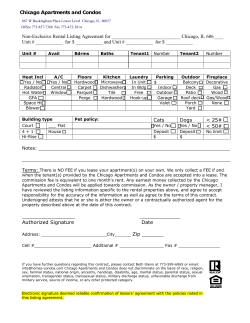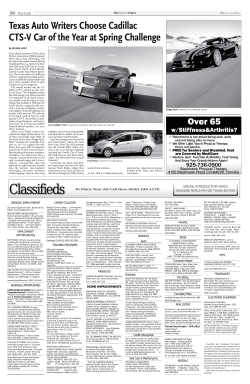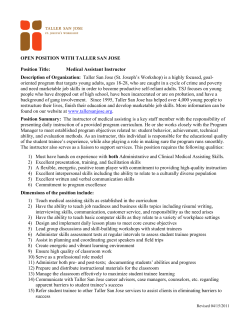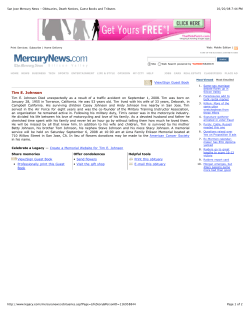
How to Tell an Airport from a Home: Techniques and Applications
How to Tell an Airport from a Home:
Techniques and Applications
Andreas Pitsillidis?∗ Yinglian Xie‡
Fang Yu‡
Martin Abadi‡† Geoffrey M. Voelker?
Stefan Savage?
?
‡
University of California, San Diego
{apitsill,voelker,savage}@cs.ucsd.edu
ABSTRACT
problems ranging from load balancing [5] to email reputation [10], as well as to enable entirely new classes of capabilities, such as geographically-specialized advertising and
proximity-oriented social networking.
However, much of the technical effort in this area has focused on accurately inferring location from available identifiers (either from IP addresses [3, 9, 11, 13] or WiFi mapping [2, 4, 7]) and comparatively little thought has been devoted to the “meaning” of these locations.1 For example, a
given user might access an Internet service from four different locations: from their home, from their business, from a
hotel on a business trip, or from a cafe. While today we can
use commercial IP geolocation tools to map each of these accesses to city-level positions, the salient context surrounding
these positions is lost.
We argue that such “location context” has a broad range
of uses and can add value for researchers, service providers,
and application developers alike. For example, restaurants
will likely find value in providing geolocalized advertising
to all users, while plumbers might limit such specialization
to users accessing the Internet from their “home” city. Similarly, data center operators might consider migrating user
account state for users whose residence has changed, but a
user accessing the same account from afar while traveling
might not merit the overhead of such migration.
In this paper we explore the proposition that “location
context” can be inferred based on the dynamics of user mobility. In particular, we argue that rough location characterizations such as “residence”, “workplace”, or “travel venue”
(e.g., hotel, airport, cafe, etc.) can be automatically derived
for many IP address ranges. Moreover, we show that this
classification can be achieved without significant infrastructure or cooperation from network operators. Instead, we rely
purely on the analysis of Internet service logs (in particular
logs of email logins and automated software updates) combined with existing IP geolocation tools.
Today’s Internet services increasingly use IP-based geolocation to specialize the content and service provisioning for
each user. However, these systems focus almost exclusively
on the current position of users and do not attempt to infer or
exploit any qualitative context about the location’s relationship with the user (e.g., is the user at home? on a business
trip?). This paper develops such a context by profiling the
usage patterns of IP address ranges, relying on known user
and machine identifiers to track accesses over time. Our preliminary results suggest that rough location categories such
as residences, workplaces, and travel venues can be accurately inferred, enabling a range of potential applications
from demographic analyses to ad specialization and security
improvements.
Categories and Subject Descriptors
C.2.0 [Computer Communication Networks]: General—
Security and protection; C.2.3 [Computer Communication
Networks]: Network Operations—Network monitoring
General Terms
Algorithms, Measurement, Security
1.
Microsoft Research Silicon Valley
{yxie,fangyu,abadi}@microsoft.com
INTRODUCTION
Designers of Internet services increasingly seek to specialize their behavior and content to reflect differences
among their users (e.g., location, bandwidth, reputation,
etc.). Location is perhaps the most widely examined of
these features and has been used to help address system
∗
The work was done at Microsoft Research Silicon Valley.
Mart´ın is also affiliated with the University of California, Santa
Cruz, and the Coll`ege de France.
†
Permission to make digital or hard copies of all or part of this work for
personal or classroom use is granted without fee provided that copies are
not made or distributed for profit or commercial advantage and that copies
bear this notice and the full citation on the first page. To copy otherwise, to
republish, to post on servers or to redistribute to lists, requires prior specific
permission and/or a fee.
Hotnets ’10, October 20–21, 2010, Monterey, CA, USA.
Copyright 2010 ACM 978-1-4503-0409-2/10/10 ...$10.00.
1
Some previous efforts have sought to extract additional context
from IP addresses, including proxy status [6], dynamic address assignment [15], accurate mapping to hosts or users [14], and identifying offered services [12]; however, none of these projects have
concerned location or indeed any issues at a level of abstraction
visible to typical users.
1
The core idea behind our approach is simple: that the
“kind” of location at a particular IP address is implicitly
revealed by the mobility patterns of the users who operate
there. For example, address ranges from which the same
users appear consistently are more likely to be residences or
workplaces, while address ranges that host a large number of
distinct users who are not seen again are more likely to represent Internet infrastructure for transient users (e.g., airports
or cafes). Conversely, a user who normally operates out of a
“residence” IP block, but is later seen to send requests from a
“travel” IP range in a major city hundreds of miles away can
be inferred to be traveling. Despite confounding factors in
such analyses (e.g., inaccuracies of IP geolocations, VPNs,
or Satellite VSAT links), we find that mining across a large
number of users can potentially provide fairly robust results.
Finally, we describe a range of use cases for location context, from pure demographic research—tracking aggregate
population migration over time—to concrete applications for
data migration, security, and specialized search/advertising.
2.
Software Update
Email-2009
Email-2008
4.0×106
16.7×106
29.4×106
8.4×109
7.5×109
home IP addresses. We use this information for the subsequent inference of IP addresses used at work places (work
IP addresses) and those used at travel locations (travel IP
addresses). During the process, we take steps to minimize
errors introduced by the inaccuracies of the geolocation data,
which is unavoidable in some cases. Since our main purpose
is to illustrate the type of classification one can derive, we
choose to be conservative in our current methods, rather than
obtaining an exhaustive list of IP addresses of each type.
(1) Identifying Home IP Addresses. We begin our classification by first deriving home IP addresses. For now, we
broadly refer to home IP addresses as those that are associated with users in their general home city and metropolitan
area. Later we perform further fine-grained classification of
these IP addresses into work IP addresses as well.
In each trace we process each user’s events individually
to identify home IP addresses. Because of DHCP effects
and local travel, home IP addresses could change frequently.
However, they should remain in the same location both topologically and geographically. So for each IP address, we
first identify its BGP prefix as well as its geographic location (city and state names), and store them in a <BGP,
Location> pair. We then identify the frequent locations accessed by the user by counting the number of days a given
<BGP, Location> pair appears in the trace. We use a sliding window of size 30 days, advanced by an increment of
one week. If we observe at least 15 active days within such
a window, we record the particular pair as a home location
candidate. At the end of our processing, we tag all IP addresses associated with home location candidates as candidate home IP addresses for that particular user.
(2) Identifying Travel IP Addresses. After having obtained the home IP address information, we proceed to infer
travel IP addresses. For each event that occurred more than
250 miles away from its user’s home location, we consider
the IP address associated with the event a candidate travel IP
address for that user. The 2009 NHTS report [1] estimates
that the largest average traveling distance per person and per
transportation mode, for work reasons, is roughly 100 miles.
Thus we conservatively set our threshold to 250 miles, which
is also bigger than the diameter of any large city in US.
(3) Filtering Proxy/VPN IP Addresses. We found that
a small number of proxy or VPN IP addresses introduce
false IP geolocation information, confusing further analysis.
For instance, social networking sites may automatically log
users into user-provided email accounts. Such login events
correspond to the IP addresses of the social networking sites,
not the users. To identify these IP addresses, we calculate a
“miles per hour” (mph) metric between two IP addresses that
CATEGORIZING IP ADDRESSES
Dataset Description
We use three large data sets for our study: a set of update
events for a large, ubiquitously deployed software package
(referred to as Software Update), collected from Aug 2009 to
Jan 2010, and two sets of user login events to a popular Web
mail provider, collected from Aug to Sep 2008 (Email-2008)
and Aug to Sep 2009 (Email-2009), respectively. The data
sets contain sampled records with anonymized host or user
IDs, IP addresses, and activity timestamps. For simplicity,
we refer to both types of IDs as users hereafter. Thus the
mobility results in the software update and email datasets
reflect host mobility and user mobility, respectively.
As a basis for categorizing IP addresses, we use data from
Quova [3], which provides the mapping of IP addresses to
geolocation. We also determine distances between events
by calculating the geographic distance of the corresponding IP addresses using the Quova data. Since we found that
Quova’s geolocation results were either unavailable or inaccurate for IP addresses outside of the United States, we restrict our analysis to events within the US. Further, to ensure
that we have a sufficient number of events to reason about
the mobility patterns of each user, we focus on only the set
of users for which we have at least 15 events from IP addresses within the US. Table 1 shows the number of events
and unique users in the traces after this filtering.
2.2
Unique users
0.5×109
Table 1: Events and users after filtering.
Our method for deriving home and travel IP addresses relies on mining user online activity logs. In this section, we
describe our datasets, our current methods, and initial results
with validations.
2.1
Total events
Classification Methods
Without prior knowledge of user travel activities, we begin with inferring IP addresses of home locations, defined as
2
were used consecutively in time by a user. The intuition is
that a user’s physical travel speed has an upper bound (set to
500 mph, a typical commercial airplane speed). If a transition between a travel and a home IP is faster than the upper
bound, then no physical travel is actually involved and we
remove the IP address from consideration.
(4) Pruning Candidate Sets. We then resolve the inconsistency between candidate home and travel IP sets, where
different users may place the same IP address into different
categories. Such inconsistencies could arise for a variety of
reasons. For instance, IP addresses can have inaccurate geolocation information and it may be inherently difficult to
pinpoint their locations (e.g., satellite IP addresses). Also,
inferring based on individual user activities may create inaccuracies. For example, we may misclassify the home and
travel addresses for a user who travels to a location for an
extended period of time.
To increase the confidence level of our classification, for
each IP address we look at its user population and examine the degree of consensus on its classification. If (1) at
least two users consistently tag this IP address as a home (or
travel) IP and (2) more than half of its population tags this IP
address in the same way, then we conservatively regard our
initial classification as accurate. Otherwise, we prune the IP
address and the corresponding ranges (from the BGP table)
from the final home (or travel) IP address set.
(5) Identifying Work IP Addresses. Finally, we differentiate IP addresses used at workplaces from those used at residences, as a first look into the possibility of performing such
fine-grained classification. This differentiation provides the
benefit of reflecting user commute patterns.
We find that 7–8% of users have more than one initial
home IP range. For these users, some of the ranges may
represent actual residences, while others may correspond to
work locations. To distinguish these two possibilities, we
perform day-of-week analysis, as work IP addresses tend to
be used only during work days, while home addresses are
mostly used at night and during weekends. Because users
are from different time zones, we analyze only the weekday
and weekend patterns. We first select home IP address pairs
that (1) are from different BGP ranges and (2) are both accessed on a single day. For the corresponding IP range pairs,
if such daily access patterns repeat for more than one day,
then we tag any range that has been active for at least 6 days
out of a 7-day window as a residence IP range; we also use
the consensus heuristic above to further increase confidence.
We classify any other range as a work IP range.
2.3
Software Update
Email-2009
Email-2008
4,419,532
64,963
1,509,617
126,244
4,088,555
284,818
Home
Travel
Table 2: Number of inferred home and travel IP addresses in each data set.
Software Update
Email-2009
Home
Desktop
Laptop
51.9%
48.1%
48.9%
51.1%
Travel
Desktop
Laptop
7.9%
92.1%
6.6%
93.4%
Table 5: Desktop and laptop breakdown.
/24s
Full IPs
Software Update
Home
Travel
Email-2009
Home Travel
882
11,050
1,107
5,797
16
20
107
127
Table 6: Overlap with known residential broadband network IP addresses.
surprisingly, the numbers of travel IPs are one order of magnitude smaller. Tables 3 and 4 show the top home and travel
cities by number of users. We observe that the top home
cities all have large populations. The top travel cities, however, also include cities with major airports (e.g., Dallas and
Denver) and high-tech companies (e.g., San Jose).
Since the three input data sets have similar properties, we
use only the Email-2009 dataset for deriving work IP addresses. In total we identified 12,431 such addresses.
Next we validate our results. To our knowledge, there
are no publicly available data sets we can use to verify our
classification of IP addresses based on usage. Instead, we
perform two tests on our results as sanity checks.
Machine Types. Our software update data set contains
information on the brands and models of the computers that
performed updates. Given that travel IP addresses are more
likely associated with mobile devices such as laptops, we
first compare the types of machines observed on home and
travel IP addresses. Since the software update data set is collected in 2009, we perform this check on the results derived
from the Software Update and Email-2009 data sets only.
Table 5 confirms our expectation that the majority (92–
93%) of the machines appearing at travel IPs are indeed laptops. In contrast, for home IP addresses we do not see significant differences between desktops and laptops. Note that
it is plausible to see a small percentage of desktops on travel
IPs because travel locations can contain desktop machines,
e.g., a hotel lobby machine shared amongst many guests.
Known Residential Broadband IPs. We also obtained
Analysis and Validation
We apply our method to all three data sets. Table 2 shows
the number of home and travel IP addresses identified in
each data set. Our method can conservatively identify millions of home IP addresses across all three datasets.2 Not
users in the latter. Consequently, we identified fewer home IP addresses from the Email-2009 dataset. The big increase of events per
user shown in Table 1 was due to activity from a number of popular online services present only in the Email-2009 dataset. These
services act as aggregators and leverage email credentials for authentication, thus do not represent actual Web mail login attempts.
2
The Email-2008 and Email-2009 data sets were collected using
different sampling rates, which resulted in capturing data for fewer
3
Software Update
Location
New York, NY
Chicago, IL
Los Angeles, CA
Atlanta, GA
Phoenix, AZ
Washington, DC
Tampa, FL
Houston, TX
Philadelphia, PA
San Diego, CA
Email-2009
# Users
% All Users
91740
68879
62623
53146
44174
43890
42657
40493
33548
32007
3.1%
2.4%
2.1%
1.8%
1.5%
1.5%
1.5%
1.4%
1.2%
1.1%
Email-2008
Location
# Users
% All Users
New York, NY
Los Angeles, CA
Chicago, IL
Phoenix, AZ
Tampa, FL
Washington, DC
San Diego, CA
Atlanta, GA
Philadelphia, PA
Salt Lake City, UT
120732
98625
76005
74671
69755
61205
48901
42709
40754
38245
3.2%
2.6%
2.0%
2.0%
1.8%
1.6%
1.3%
1.1%
1.1%
1.0%
Location
# Users
% All Users
New York, NY
Los Angeles, CA
Phoenix, AZ
Tampa, FL
Washington, DC
Chicago, IL
San Diego, CA
Philadelphia, PA
Atlanta, GA
Seattle, WA
295441
207864
148192
137344
125269
121614
106694
89093
82715
82383
3.7%
2.6%
1.8%
1.7%
1.6%
1.5%
1.3%
1.1%
1.0%
1.0%
Table 3: Top home cities by number of users.
Software Update
Location
Atlanta, GA
Dallas, TX
Chicago, IL
New York, NY
Denver, CO
Newark, NJ
San Jose, CA
Sacramento, CA
Ashburn, VA
Orlando, FL
Email-2009
# Users
% All Users
8919
7124
6939
6376
5089
3875
3819
3780
3506
3137
7.2%
5.7%
5.6%
5.1%
4.1%
3.1%
3.1%
3.0%
2.8%
2.5%
Location
Atlanta, GA
Chicago, IL
Dallas, TX
Sacramento, CA
Newark, NJ
San Jose, CA
New York, NY
Ashburn, VA
Denver, CO
Orlando, FL
Email-2008
# Users
% All Users
14501
12450
11768
11488
10549
10255
9508
8232
7130
5240
5.9%
5.1%
4.8%
4.7%
4.3%
4.2%
3.9%
3.3%
2.9%
2.1%
Location
Chicago, IL
Atlanta, GA
Dallas, TX
Sacramento, CA
San Jose, CA
Newark, NJ
Ashburn, VA
New York, NY
Fort Worth, TX
Phoenix, AZ
# Users
% All Users
30501
28956
24629
24176
23794
18534
16324
13021
12484
12026
6.2%
5.9%
5.0%
4.9%
4.9%
3.8%
3.3%
2.7%
2.6%
2.5%
Table 4: Top travel cities by number of users.
a small set of verified residential broadband network IP addresses provided by [8]. This dataset consists of 3,613 IP
addresses anonymized by removing the last 8 bits of each
address, spanning 2,099 distinct /24 subnets.
We evaluate the overlap of our results with this known set
of addresses in the following two ways. First, since the provided data is essentially /24 IP blocks, we convert our result
sets into the same format and determine their overlap at this
granularity. Second, we expand the broadband residential IP
set to include all individual addresses in the /24 range and
then examine the overlap. Again, we compare only the IP
sets derived using the 2009 data sets. Table 6 shows the comparison results. As expected, there is a significant difference
between the home and travel IP sets: only a small number
travel IP addresses overlap with the broadband residential IP
set, yet the number of overlapping home IP addresses is orders of magnitude more. This difference suggests that we
correctly identified home IP addresses.
While we strive to maximize our confidence in the validity of the current results, we acknowledge that finer-grained
classifications are likely to be possible.
3.
Destination
New York
Texas
Colorado
California
Washington
Montana
Virginia
Texas
New York
Wyoming
Illinois
West Virginia
Arizona
Illinois
Texas
Colorado
Illinois
Florida
Florida
Montana
# Users
% All Users
561
551
539
499
440
348
286
224
201
156
4.3%
4.2%
4.1%
3.8%
3.4%
2.7%
2.2%
1.7%
1.5%
1.2%
Table 7: Top location pairs for long-term migration.
derstanding such long-term mobility can provide a global
view of the user population for tasks such as resource provisioning and location-based feature planning. Although ISPs
may derive their own customer moving trends with user profiles or network traces, their data points are often limited to
a single administrative domain. Government agencies also
collect census data to study relocation trends. However, a
census requires great manual effort and is only feasible infrequently.
We use the email data sets to identify users whose home
locations changed from one year to the next. Referring back
to Table 3, we see that New York and Los Angeles remain
the top two cities in 2008 to 2009 with the largest number of
user home IP addresses, while Chicago’s number increased
significantly. Further examining the home IP relocation patterns for individual users, Table 7 shows the top pairs of location changes over the year in terms of movement between
states. To conclude that the change was a relocation, we
use a conservative threshold of at least 500 miles in the dis-
USER MOBILITY
In this section, we perform an initial study on user mobility to illustrate the type of mobility patterns one might derive
from our classification.
3.1
Origin
Long-term Mobility
The concept of home locations for users enables us to examine long-term mobility trends as users change their home
locations—literally move home—over long time scales. Un4
35
31.9 32.0
Percentage of users
30
27.5 27.4
Software Update
Email-2009
25
20.8 20.5
20
15
12.5
13.7
10
5 4.4 3.9
0
<50
2.9 2.5
50 to 100
100 to 500 500 to 1000 1000 to 2000
Maximum distance travelled (miles)
>2000
Figure 2: Maximum distance traveled.
Figure 1: Long-term relocation patterns across states.
.
Origin
Destination
Los Angeles, CA
Atlanta, GA
Chicago, IL
Chicago, IL
Phoenix, AZ
Ashburn, VA
Atlanta, GA
Atlanta, GA
San Diego, CA
Chicago, IL
San Jose, CA
Tampa, FL
Minneapolis, MN
New York, NY
San Jose, CA
Los Angeles, CA
Dallas, TX
Orlando, FL
San Jose, CA
Saint Louis, MO
# Users
% All Users
491
432
399
381
336
322
314
300
287
282
0.8%
0.7%
0.6%
0.6%
0.5%
0.5%
0.5%
0.5%
0.5%
0.4%
may be viable. For instance, strategies for data migration
and caching might benefit from the categorization: users typically spend just a few hours at airports, while they could
spend days at hotels and years at home locations, and these
different time scales may inform the decision of whether to
migrate user data.
4.1
The classification of home and travel IP addresses provides new opportunities for online applications to understand user profiles. Based on the location categories of a
user, we could infer their interests or intentions to customize
search results and to target advertisement. For example,
travel-related links may have higher rankings when the query
comes from a travel IP address.
We have verified, as an example, that search patterns from
known airport IP ranges are different from those in nearby
residential IP ranges. We examined the search log from a
large search engine, computed the percentage of users that
make queries containing ten travel-related keywords including “flight”, “airline”, and “travel”, and observed three times
higher percentages at the airports.
Advertising can also be more specialized based on the location of the user; it is for example less likely that users are
interested in home repair services, if they are utilizing travel
IPs. In a similar manner, local attractions can be of more
interest to such users.
Using two weeks of query and ad-click logs from a large
search engine, we extracted two sets of queries that resulted
in online-ad conversions from travel and home IP address
sets, respectively. For each set of queries, we examined the
vocabularies and identified the top 100 most frequent words.
In total about 30% of these query words are disjoint (i.e.,
appeared in one set but not in the other). Table 9 shows the
top five query words from the disjoint sets. Not surprisingly,
home users are more interested in advertisement about job
opportunities (with keyword “employment” and “applications”), while travel users tend to search for information related with entertainment, accommodations, and transportation. Further, for the remaining 70% words that are popular
across both set of IP addresses, their rankings are also signif-
Table 8: Top short-term travel pairs.
tance home locations changed. We see that Illinois (mostly
Chicago) indeed is a popular relocation destination. More
generally, Figure 1 shows that the user population we study
exhibits a coast-to-inland moving trend from 2008 to 2009,
perhaps because of reduced job opportunities in locations
such as New York and California.
3.2
Short-term Mobility
Next we examine short-term user mobility, where users
travel temporarily and return to their home locations later.
Such short-term travel patterns are often useful for applications that would benefit from user population profiles, e.g.,
targeted advertisement. Figure 2 shows that close to 40% of
users travel no further than 500 miles, suggesting strong locality of short-term mobility.3 Interestingly, Table 8 shows
that the top travel route is from Los Angeles to San Jose.
On the other hand, Chicago and Atlanta are popular travel
sources, possibly because of a combination of large populations and major travel hubs.
4.
Search and Advertisement
APPLICATIONS
Since we perform our inference at the IP-address level,
many services can easily take advantage of this information
for processing requests from users or remote hosts. In this
section, we outline a few applications, focusing on search
and advertisement and on security. Many other applications
3
The results obtained by using different input data sets are very
similar, so we present only the measurements from the Email-2009
data set here.
5
cause of the denser user population. An interesting direction
of future work is thus to explore different defense strategies
at travel locations.
Furthermore, the different security properties of travel and
home IP addresses suggest new possibilities for detecting the
use of compromised accounts by attackers and other similar
fraudulent activity. For example, user-login events from several new IP addresses within a few hours seem more likely
to be benign if these addresses are at travel locations than if
they are in residences. In the former case, the user may simply be traveling; in the latter case, the events may be from
bots that employ the user’s account for sending spam.
Disjoint query words (top 5 only)
Travel IPs
Home IPs
moving, universal, movies, inn, cars
employment, applications, cruises, food-stamps, college
Table 9: Top disjoint query words.
Total (106 )
Malicious (103 )
Percentage
IPs
Home
Events
IDs
IPs
Travel
Events
IDs
1.5
6.5
0.4%
432.2
595.8
0.1%
3.1
190.9
6.2%
0.1
1.1
0.9%
5.8
119.7
2.0%
1.4
101.1
7.2%
Table 10: Prevalence of malicious activity events.
Events per IP
User IDs per IP
Events per user ID
Home
Travel
286.3
2.0
140.8
46.3
11.1
4.2
5.
This paper explores the notion of “location context”.
Specifically, we develop techniques to derive context about
the locations where users access the network (home, work,
travel) by analyzing user mobility patterns from large service
logs. We show that these techniques can scale to the Internet despite a number of practical challenges. Using concrete
examples, we show that “location context” can provide interesting characteristics of users and their activities for a variety
of applications.
Table 11: Home and travel IP event statistics.
icantly different. For example, “hotel” is among the 20 most
popular words for travel users, but is used less frequently by
home users (with rank 56).
4.2
SUMMARY
Mobility and Security
Next, we explore whether home and travel IP addresses
show different security properties. The answers to this question could have implications for defense strategies.
We evaluate the security-related characteristics of the
home and travel IP sets derived from the Email-2009 data.
For this application, we rely on labels from the data provider
distinguishing malicious spammer accounts from legitimate
user accounts.4 To our surprise, Table 10 shows that the percentage of malicious login events is 20 times higher at travel
IP addresses than at home IP addresses, suggesting access
from travel IP addresses should operate under more stringent security policies. Moreover, the larger percentage of
malicious login events at travel locations also suggests there
might exist other types of malicious activities on those hosts,
such as spreading attacks to compromise more computers.
Thus machines at travel IPs may potentially be more vulnerable than home computers.
The overall event statistics in Table 11 also show interesting characteristics. For the number of user IDs per IP address, the travel set is an order of magnitude higher than the
home IP set (i.e., a larger concentration of users in a smaller
travel IP space). However, the number of events per user in
the travel set is two orders of magnitude smaller, as users
often spend less time in travel locations and so access their
accounts less frequently.
Because travel IP addresses are shared much more frequently, directly blacklisting them is likely to generate
higher false positive rates. On the other hand, attackers may
prefer choosing travel locations to launch their attacks be-
6.
[1]
[2]
[3]
[4]
[5]
[6]
[7]
[8]
[9]
[10]
[11]
[12]
[13]
[14]
[15]
4
These labels were marked based on detection performed by the
data provider. They typically have a low false positive rate, but
may have false negatives.
6
REFERENCES
National Household Travel Survey. http://nhts.ornl.gov/.
Navizon virtual GPS service. http://www.navizon.com/.
Quova. http://www.quova.com/.
Skyhook. http://www.skyhookwireless.com/.
S. Agarwal, J. Dunagan, N. Jain, S. Saroiu, and A. Wolman. Volley:
Automated data placement for geo-distributed cloud services. In
Proceedings of NSDI, Apr. 2010.
M. Casado and M. J. Freedman. Peering through the shroud: The
effect of edge opacity on IP-based client identification. In
Proceedings of NSDI, Apr. 2007.
J. Cheng, S. H. Y. Wong, H. Yang, and S. Lu. SmartSiren: Virus
detection and alert for smartphones. In MobiSys, June 2007.
M. Dischinger, A. Haeberlen, K. P. Gummadi, and S. Saroiu.
Characterizing residential broadband networks. In Proceedings of the
7th ACM SIGCOMM Conference on Internet Measurement
(IMC’07), Oct 2007.
B. Eriksson, P. Bardford, J. Sommers, and R. Nowak. A
learning-based approach for IP geolocation. In Proceedings of the
Passive and Active Measurement Conference (PAM), Apr. 2010.
S. Hao, N. A. Syed, N. Feamster, A. G. Gray, and S. Krasser.
Detecting spammers with SNARE: Spatio-temporal network-level
automatic reputation engine. In Proceedings of USENIX, Aug. 2009.
V. N. Padmanabhan and L. Subramanian. An investigation of
geographic mapping techniques for Internet hosts. In Proceedings of
ACM SIGCOMM, Aug. 2001.
I. Trestian, S. Ranjan, A. Kuzmanovic, and A. Nucci. Unconstrained
endpoint profiling (Googling the internet). In Proceedings of ACM
SIGCOMM, Aug. 2008.
B. Wong, I. Stoyanov, and E. G. Sirer. Octant: A comprehensive
framework for the geolocalization of Internet hosts. In Proceedings
of NSDI, Apr. 2007.
Y. Xie, F. Yu, and M. Abadi. De-anonymizing the Internet Using
Unreliable IDs. In Proceedings of ACM SIGCOMM, Aug. 2009.
Y. Xie, F. Yu, K. Achan, E. Gillum, M. Goldszmidt, and T. Wobber.
How dynamic are IP addresses? In Proceedings of ACM SIGCOMM,
Aug. 2007.
© Copyright 2025

















